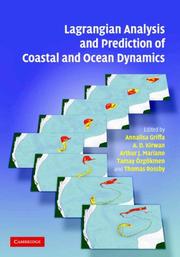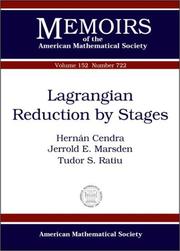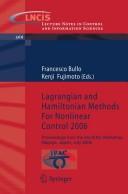| Listing 1 - 8 of 8 |
Sort by
|

ISBN: 9780521870184 9780511535901 9780511275586 0511275587 0511274882 9780511274886 0511273355 9780511273353 0511274149 9780511274145 1280815760 9781280815768 0511535902 0521870186 1107171563 9786610815760 0511321082 Year: 2007 Publisher: Cambridge Cambridge University Press
Abstract | Keywords | Export | Availability | Bookmark
 Loading...
Loading...Choose an application
- Reference Manager
- EndNote
- RefWorks (Direct export to RefWorks)
Written by a group of international experts in their field, this book is a review of Lagrangian observation, analysis and assimilation methods in physical and biological oceanography. This multidisciplinary text presents new results on nonlinear analysis of Lagrangian dynamics, the prediction of particle trajectories, and Lagrangian stochastic models. It includes historical information, up-to-date developments, and speculation on future developments in Lagrangian-based observations, analysis, and modeling of physical and biological systems. Containing contributions from experimentalists, theoreticians, and modellers in the fields of physical oceanography, marine biology, mathematics, and meteorology, this book will be of great interest to researchers and graduate students looking for both practical applications and information on the theory of transport and dispersion in physical systems, biological modelling, and data assimilation.
Ocean currents --- Lagrange equations. --- D'Alembert equation --- Equations, Euler-Lagrange --- Equations, Lagrange --- Euler-Lagrange equations --- Lagrangian equations --- Differential equations --- Equations of motion --- Currents, Oceanic --- Ocean circulation --- Water currents --- Ocean surface topography --- Mathematical models. --- Hydrodynamique --- Océanographie
Book
ISBN: 1316589919 1316590100 1316407101 1316591247 1316590291 1316590488 1316588777 9781316407103 9781316591246 9781316590485 9781316591055 1316591050 9781107554979 1107554977 Year: 2016 Publisher: Cambridge
Abstract | Keywords | Export | Availability | Bookmark
 Loading...
Loading...Choose an application
- Reference Manager
- EndNote
- RefWorks (Direct export to RefWorks)
The rigorous mathematical theory of the Navier-Stokes and Euler equations has been a focus of intense activity in recent years. This volume, the product of a workshop in Venice in 2013, consolidates, surveys and further advances the study of these canonical equations. It consists of a number of reviews and a selection of more traditional research articles on topics that include classical solutions to the 2D Euler equation, modal dependency for the 3D Navier-Stokes equation, zero viscosity Boussinesq equations, global regularity and finite-time singularities, well-posedness for the diffusive Burgers equations, and probabilistic aspects of the Navier-Stokes equation. The result is an accessible summary of a wide range of active research topics written by leaders in their field, together with some exciting new results. The book serves both as a helpful overview for graduate students new to the area and as a useful resource for more established researchers.
Differential equations, Partial. --- Navier-Stokes equations. --- Lagrange equations. --- D'Alembert equation --- Equations, Euler-Lagrange --- Equations, Lagrange --- Euler-Lagrange equations --- Lagrangian equations --- Differential equations --- Equations of motion --- Equations, Navier-Stokes --- Differential equations, Partial --- Fluid dynamics --- Viscous flow --- Partial differential equations
Book
ISBN: 3319503553 3319503545 Year: 2017 Publisher: Cham : Springer International Publishing : Imprint: Birkhäuser,
Abstract | Keywords | Export | Availability | Bookmark
 Loading...
Loading...Choose an application
- Reference Manager
- EndNote
- RefWorks (Direct export to RefWorks)
This book focuses on the interplay between Eulerian and Lagrangian conservation laws for systems that admit physical motivation and originate from continuum mechanics. Ultimately, it highlights what is specific to and beneficial in the Lagrangian approach and its numerical methods. The two first chapters present a selection of well-known features of conservation laws and prepare readers for the subsequent chapters, which are dedicated to the analysis and discretization of Lagrangian systems. The text is at the frontier of applied mathematics and scientific computing and appeals to students and researchers interested in Lagrangian-based computational fluid dynamics. It also serves as an introduction to the recent corner-based Lagrangian finite volume techniques.
Conservation laws (Mathematics) --- Lagrange equations. --- D'Alembert equation --- Equations, Euler-Lagrange --- Equations, Lagrange --- Euler-Lagrange equations --- Lagrangian equations --- Mathematics. --- Partial differential equations. --- Computer mathematics. --- Computational Mathematics and Numerical Analysis. --- Partial Differential Equations. --- Computer science --- Differential equations, partial. --- Partial differential equations --- Computer mathematics --- Discrete mathematics --- Electronic data processing --- Mathematics --- Differential equations --- Equations of motion --- Differential equations, Hyperbolic
Book
ISBN: 1108299547 1108297943 1108299865 1139021028 1108301789 1108300189 1108300502 9781108301787 9781139021029 9781108300506 0521869021 9780521869027 Year: 2017 Publisher: Cambridge Cambridge University Press
Abstract | Keywords | Export | Availability | Bookmark
 Loading...
Loading...Choose an application
- Reference Manager
- EndNote
- RefWorks (Direct export to RefWorks)
The principle of least action originates in the idea that, if nature has a purpose, it should follow a minimum or critical path. This simple principle, and its variants and generalizations, applies to optics, mechanics, electromagnetism, relativity, and quantum mechanics, and provides an essential guide to understanding the beauty of physics. This unique text provides an accessible introduction to the action principle across these various fields of physics, and examines its history and fundamental role in science. It includes - with varying levels of mathematical sophistication - explanations from historical sources, discussion of classic papers, and original worked examples. The result is a story that is understandable to those with a modest mathematical background, as well as to researchers and students in physics and the history of physics.
Least action. --- Variational principles. --- Mechanics. --- Lagrange equations. --- Hamilton-Jacobi equations. --- Equations, Hamilton-Jacobi --- Equations, Jacobi-Hamilton --- Jacobi-Hamilton equations --- Calculus of variations --- Differential equations, Partial --- Hamiltonian systems --- Mechanics --- D'Alembert equation --- Equations, Euler-Lagrange --- Equations, Lagrange --- Euler-Lagrange equations --- Lagrangian equations --- Differential equations --- Equations of motion --- Classical mechanics --- Newtonian mechanics --- Physics --- Dynamics --- Quantum theory --- Extremum principles --- Minimal principles --- Variation principles --- Variational principles
Book
ISBN: 128038493X 9786613562852 9048123933 9048123925 9789048123926 9789048123933 Year: 2009 Publisher: Dordrecht Springer Netherlands
Abstract | Keywords | Export | Availability | Bookmark
 Loading...
Loading...Choose an application
- Reference Manager
- EndNote
- RefWorks (Direct export to RefWorks)
The aim of this work is to bridge the gap between the well-known Newtonian mechanics and the studies on chaos, ordinarily reserved to experts. Several topics are treated: Lagrangian, Hamiltonian and Jacobi formalisms, studies of integrable and quasi-integrable systems. The chapter devoted to chaos also enables a simple presentation of the KAM theorem. All the important notions are recalled in summaries of the lectures. They are illustrated by many original problems, stemming from real-life situations, the solutions of which are worked out in great detail for the benefit of the reader. This book will be of interest to undergraduate students as well as others whose work involves mechanics, physics and engineering in general.
Hamiltonian systems. --- Lagrange equations. --- Mathematical physics. --- Physical mathematics --- Physics --- D'Alembert equation --- Equations, Euler-Lagrange --- Equations, Lagrange --- Euler-Lagrange equations --- Lagrangian equations --- Differential equations --- Equations of motion --- Hamiltonian dynamical systems --- Systems, Hamiltonian --- Differentiable dynamical systems --- Mathematics --- Mechanics. --- Statistical physics. --- Classical Mechanics. --- Complex Systems. --- Classical Electrodynamics. --- Statistical Physics and Dynamical Systems. --- Mathematical statistics --- Classical mechanics --- Newtonian mechanics --- Dynamics --- Quantum theory --- Statistical methods --- Dynamical systems. --- Optics. --- Electrodynamics. --- Light --- Dynamical systems --- Kinetics --- Mechanics, Analytic --- Force and energy --- Mechanics --- Statics

ISSN: 00659266 ISBN: 0821827154 Year: 2001 Publisher: Providence, R.I. American Mathematical Society
Abstract | Keywords | Export | Availability | Bookmark
 Loading...
Loading...Choose an application
- Reference Manager
- EndNote
- RefWorks (Direct export to RefWorks)
Differential equations --- Classical mechanics. Field theory --- Differentiable dynamical systems --- Lagrange equations --- Variational principles --- Extremum principles --- Minimal principles --- Variation principles --- Calculus of variations --- D'Alembert equation --- Equations, Euler-Lagrange --- Equations, Lagrange --- Euler-Lagrange equations --- Lagrangian equations --- Equations of motion --- Differential dynamical systems --- Dynamical systems, Differentiable --- Dynamics, Differentiable --- Global analysis (Mathematics) --- Topological dynamics --- Lagrange equations. --- Lagrange, Équations de --- Differentiable dynamical systems. --- Systèmes dynamiques --- Variational principles. --- Principes variationnels --- Lagrange, Équations de. --- Systèmes dynamiques. --- Principes variationnels.

ISBN: 9783540738893 3540738894 3540738908 Year: 2007 Volume: 366 Publisher: Berlin, Germany ; New York, New York : Springer,
Abstract | Keywords | Export | Availability | Bookmark
 Loading...
Loading...Choose an application
- Reference Manager
- EndNote
- RefWorks (Direct export to RefWorks)
Nonlinear control theory --- Lagrange equations --- Hamiltonian systems --- Commande non linéaire --- Systèmes hamiltoniens --- Congresses --- Congrès --- Operations Research --- Civil & Environmental Engineering --- Engineering & Applied Sciences --- D'Alembert equation --- Equations, Euler-Lagrange --- Equations, Lagrange --- Euler-Lagrange equations --- Lagrangian equations --- Engineering. --- System theory. --- Control engineering. --- Robotics. --- Mechatronics. --- Control, Robotics, Mechatronics. --- Systems Theory, Control. --- Differential equations --- Equations of motion --- Systems, Theory of --- Systems science --- Science --- Philosophy --- Systems theory. --- Mechanical engineering --- Microelectronics --- Microelectromechanical systems --- Automation --- Machine theory --- Control engineering --- Control equipment --- Control theory --- Engineering instruments --- Programmable controllers
Book
ISBN: 3319530224 3319530216 Year: 2017 Publisher: Cham : Springer International Publishing : Imprint: Springer,
Abstract | Keywords | Export | Availability | Bookmark
 Loading...
Loading...Choose an application
- Reference Manager
- EndNote
- RefWorks (Direct export to RefWorks)
This book uses the Lagrangian approach, especially useful and convenient for studying large-scale transport and mixing in the ocean, to present a detailed view of ocean circulation. This approach focuses on simulations and on monitoring the trajectories of fluid particles, which are governed by advection equations. The first chapter of the book is devoted to dynamical systems theory methods, which provide the framework, methodology and key concepts for the Lagrangian approach. The book then moves on to an analysis of chaotic mixing and cross-stream transport in idealized models of oceanic meandering currents like the Gulfstream in the Atlantic, the Kuroshio in the Pacific, and Antarctic Circumpolar Current, after which the current state of physical oceanography is reviewed. The latter half of the book applies the techniques and methods already described in order to study eddies, currents, fronts and large-scale mixing and transport in the Far-Eastern seas and the north-western part of the Pacific Ocean. Finally, the book concludes with a discussion of Lagrangian simulation and monitoring of water contamination after the Fukushima disaster of 2011. The propagation of Fukushima-derived radionuclides, surface transport across the Kuroshio Extension current, and the role of mesoscale eddies in the transport of Fukushima-derived cesium isotopes in the ocean are examined, and a comparison of simulation results with actual measurements are presented. Written by some of the world leaders in the application of Lagrangian methods in oceanography, this title will be of benefit to the oceanographic community by presenting the necessary background of the Lagrangian approach in an accessible manner.
Physics. --- Oceanography. --- Fluids. --- Environmental monitoring. --- Environmental sciences. --- Applications of Nonlinear Dynamics and Chaos Theory. --- Fluid- and Aerodynamics. --- Monitoring/Environmental Analysis. --- Math. Appl. in Environmental Science. --- Ocean currents --- Lagrange equations. --- Navier-Stokes equations. --- Mathematical models. --- Equations, Navier-Stokes --- D'Alembert equation --- Equations, Euler-Lagrange --- Equations, Lagrange --- Euler-Lagrange equations --- Lagrangian equations --- Currents, Oceanic --- Differential equations, Partial --- Fluid dynamics --- Viscous flow --- Differential equations --- Equations of motion --- Ocean circulation --- Water currents --- Ocean surface topography --- Environmental science --- Science --- Oceanography, Physical --- Oceanology --- Physical oceanography --- Thalassography --- Earth sciences --- Marine sciences --- Ocean --- Statistical physics. --- Biomonitoring (Ecology) --- Ecological monitoring --- Environmental quality --- Monitoring, Environmental --- Applied ecology --- Environmental engineering --- Pollution --- Hydraulics --- Mechanics --- Physics --- Hydrostatics --- Permeability --- Mathematical statistics --- Measurement --- Monitoring --- Statistical methods
| Listing 1 - 8 of 8 |
Sort by
|

 Search
Search Feedback
Feedback About UniCat
About UniCat  Help
Help News
News